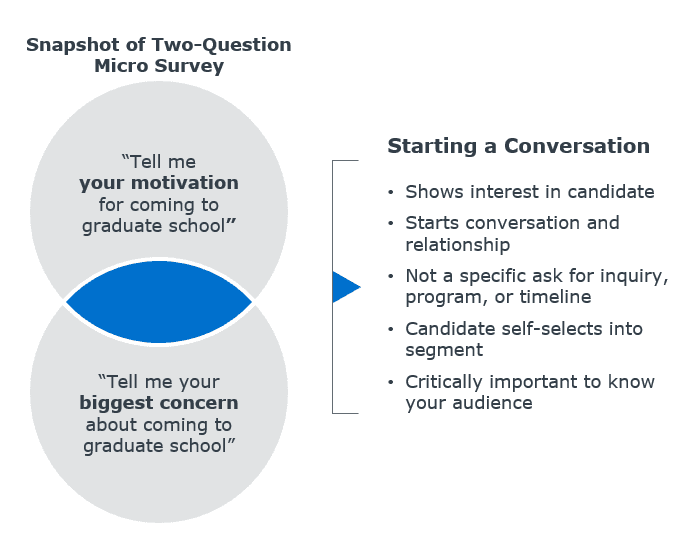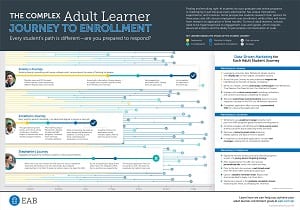Three years ago, I found myself at a crossroads.
My boss approached me about an opportunity to lead EAB’s new Adult Learner Recruitment team. The role would require relocating my family from the hustle and bustle of Washington, D.C. to a slower pace of life in Richmond, Virginia. I’d also be leaving my corporate marketing roots behind in favor of something new—higher ed marketing.
Three years, one U-Haul, and countless plates of southern food later, I’ve had the pleasure of partnering with 100+ schools to help them recruit students to graduate, online, and undergraduate degree completion programs. I’ve learned so much from our Adult Learner Recruitment partners along the way. And while I can’t chronicle everything I’ve learned in one blog post, here are four of the most important lessons I’ve learned so far:
1. Every prospect’s journey is unique, and different messaging is necessary at each stage of their journey
When I first joined the Adult Learner Recruitment team, I was struck by how often universities use the same message to recruit students, regardless of where they are in their journey to enrollment. To turn prospects into students, universities need to meet students where they are—with the right message, at the right time.
I often compare the student journey to the stages of buying a car. First, consumers have to become aware of the car. For example, a consumer may learn about the Lincoln MKC from an ad featuring Matthew McConaughey staring down a bull from the comfort of an SUV. The McConaughey ad shows off the Lincoln’s sleek interior and encourages the consumer to think, “I could see myself driving this car.”
But that commercial wouldn’t resonate with consumers about to make a purchase. At the “decision” stage, consumers want information about safety features and MPG. I’ve learned the same principle applies to adult learners researching academic programs. With our Adult Learner Recruitment clients, it’s critical we use different messaging and channels along students’ journey to enrollment.
For example, custom social media ads drive initial awareness of a school or program. But as prospective students get closer to application and enrollment, we use more targeted communications, like direct mail packages, email, and SMS messaging. The message also looks a little different. At this stage, our clients highlight graduate outcomes and course requirements, as well as upcoming application deadlines. Meeting students where they are has been a powerful lesson for our clients and team.

2. Word-of-mouth marketing is a critical—and overlooked—part of recruitment strategy
It probably comes as no surprise that students often hear about their university or program from a friend or coworker. In fact, we learned that 40% of students first heard about their chosen program from a friend, colleague, family member, or professor.
40%

But in today’s market, it’s not enough to hope that word-of-mouth marketing will happen organically. In our work with clients, we learned that universities generate more enrollments from word-of-mouth marketing when they incorporate current students, alumni, and faculty into marketing strategy.
One of my favorite examples comes from our partners at Texas A&M University’s Mays Business School. Mays created Mays MasterCast, a podcast featuring interviews with students, alumni, faculty, and friends of the school. Each episode builds connections between listeners and the Mays community and allows busy adults to engage with Mays while commuting to work or dropping their kids off at school.
3. Go beyond inquire and apply CTAs
When I left corporate marketing for higher education marketing, one of the first things I noticed was universities primarily used two calls to action: inquire and apply. These are not small asks of prospects’ time, and not all prospects are ready to take these steps.
We tested and re-tested countless ways to engage prospects. The results surprised me. For example, we’ve found success developing two-question, multiple choice micro-surveys like the one below. These surveys take seconds for prospects to complete. But for our clients, they open a conversation with the prospect and shed light on their motivations and hesitations. Survey responses can then be used to create customized messaging which addresses the goals and concerns the prospect shared.

4. Your website is the gateway to your university
If students don’t learn about your institution from a friend or colleague, chances are they found your university through your website. Thirty-two percent of adult learners in our survey found their institution through online research, including university webpages.
While I wasn’t surprised to learn websites are often students’ first impression of a university or program, I was surprised the website is often their only impression. Students may not stick around to learn more if the information they need is hard to find or missing from your website.

In our audits for Adult Learner Recruitment clients, we’ve found information like program cost is often buried or absent from program websites. Admissions deadlines and program contact information can also be difficult to find. Adding this critical information—and presenting it clearly—has been transformative in students’ experience and engagement with university websites.
The impact of these lessons—and dozens of others—on the universities we work with reminds me daily I took the right turn at that crossroads. Three years and 100 clients later, I’m thrilled to continue sharing these insights with our university partners.



